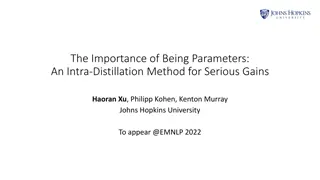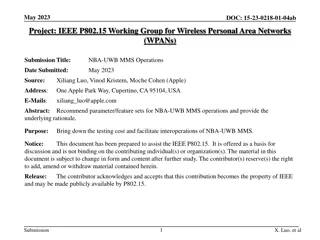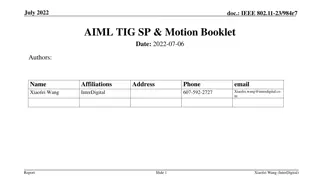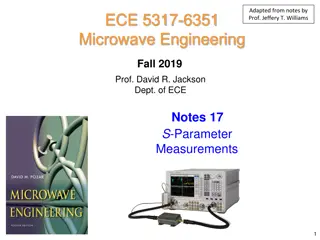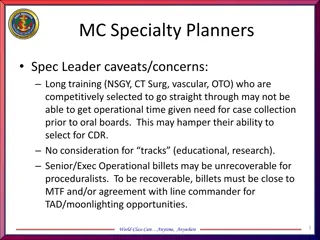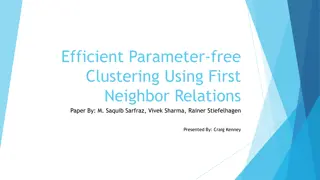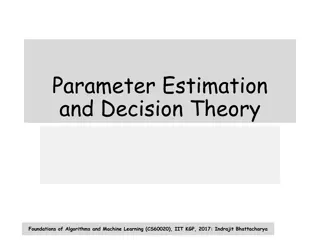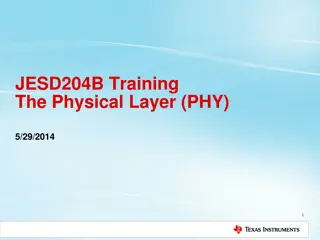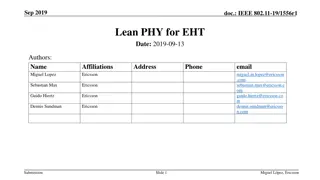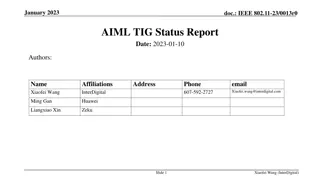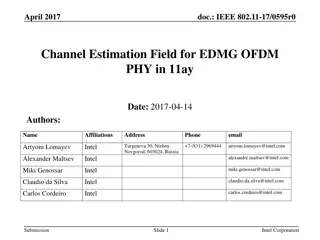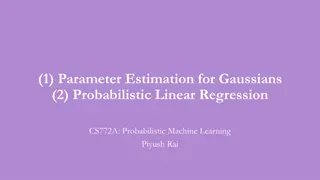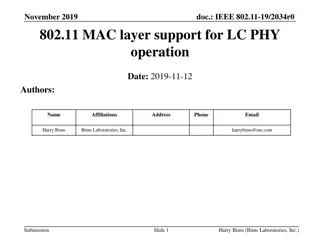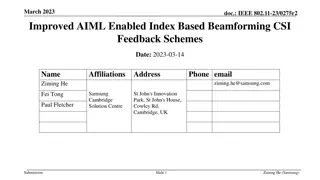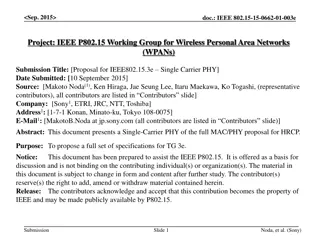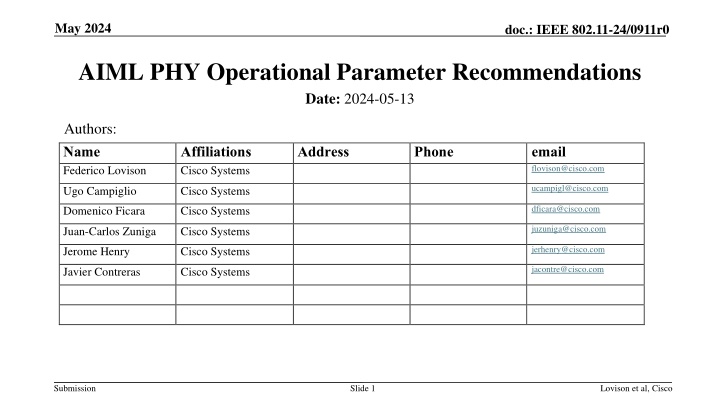
IEEE 802.11-24/AIML: AP-Assisted PHY Operational Parameter Recommendations
Explore the proposed mechanism for APs to provide PHY operational parameter recommendations to STAs, enhancing energy efficiency and privacy. Learn how AIML techniques estimate performance impacts on STAs' uplink transmissions, aiming to optimize energy consumption while maintaining desired performance levels within STAs. Discover how the mechanism considers current BSS status and STA connection statistics for efficient parameter selection. Implement privacy-related use cases like TX power randomization for increased energy efficiency and privacy.
Download Presentation

Please find below an Image/Link to download the presentation.
The content on the website is provided AS IS for your information and personal use only. It may not be sold, licensed, or shared on other websites without obtaining consent from the author. If you encounter any issues during the download, it is possible that the publisher has removed the file from their server.
You are allowed to download the files provided on this website for personal or commercial use, subject to the condition that they are used lawfully. All files are the property of their respective owners.
The content on the website is provided AS IS for your information and personal use only. It may not be sold, licensed, or shared on other websites without obtaining consent from the author.
E N D
Presentation Transcript
May 2024 doc.: IEEE 802.11-24/0911r0 AIML PHY Operational Parameter Recommendations Date: 2024-05-13 Authors: Name Federico Lovison Affiliations Cisco Systems Address Phone email flovison@cisco.com ucampigl@cisco.com Ugo Campiglio Cisco Systems dficara@cisco.com Domenico Ficara Cisco Systems juzuniga@cisco.com Juan-Carlos Zuniga Cisco Systems jerhenry@cisco.com Jerome Henry Cisco Systems jacontre@cisco.com Javier Contreras Cisco Systems Submission Slide 1 Lovison et al, Cisco
May 2024 doc.: IEEE 802.11-24/0911r0 Abstract Proposed mechanism allowing APs to provide PHY operational parameters range recommendations to the STAs. Intended use cases include energy saving and privacy. AIML techniques applied to estimate the impact of the changes to the STAs uplink transmissions. Submission Slide 2 Lovison et al, Cisco
May 2024 doc.: IEEE 802.11-24/0911r0 Background The AP can use different mechanisms to influence the STAs Tx power (e.g., BSS coloring, Transmit Power Envelope), aimed at enforcing regulatory limits as well as controlling interference in OBSS operations. When a STA modifies its operating parameters, there may be unintended impacts to the link quality, which are detected only after such parameters are applied. Submission Slide 3 Lovison et al, Cisco
May 2024 doc.: IEEE 802.11-24/0911r0 AP-assisted PHY parameter selection The proposed mechanism allows the AP to provide the STA with recommendations about the PHY settings that can be used to minimize energy consumption, while maintaining the performance impact within the STA s desired range. The acceptable impact is specified by the STA, according to the application requirements. The AP-generated recommendation considers current BSS status as well as receiver-side STA connection statistics. Submission Slide 4 Lovison et al, Cisco
May 2024 doc.: IEEE 802.11-24/0911r0 Use cases In addition to increased energy efficiency, the proposed recommendation mechanism allows implementing privacy-related use cases, such as the TX power randomization scheme currently being discussed in the TGbi [1]. Submission Slide 5 Lovison et al, Cisco
May 2024 doc.: IEEE 802.11-24/0911r0 Operation: STA request Proposed extension to the dot11SpectrumManagement, adding flag to advertise the AP capability to provide PHY parameters recommendations to STAs. STA to send a PHY recommendation request: Indicating its current transmit power and link margin (similar to TPC report) Indicating the acceptable performance degradation (e.g., for metrics such as retry rate) Indicating what parameters can be changed (e.g., Tx Power, SS, Channel width, MCS range) Submission Slide 6 Lovison et al, Cisco
May 2024 doc.: IEEE 802.11-24/0911r0 Operation: AP response The AP responds with a recommendation including the indication of the settings expected to meet the STA s request, for instance: Min Tx power for each bandwidth Min SS Max MCS Recommendation means that the receiving STA maintains full control as to what PHY parameters to use. Submission Slide 7 Lovison et al, Cisco
May 2024 doc.: IEEE 802.11-24/0911r0 Operation: Accuracy The confidence on the recommendation s accuracy and longevity depends on the available link statistics (e.g., the longer a STA has been connected, and as stable the connection has been, the more accurate the prediction can be). The algorithm used to generate the recommendation at the AP side would also compute a confidence metric, to be shared on the response to the STA. In case the accuracy is too low, the AP doesn t return any recommendation and can optionally add a reason code to provide an explanation (e.g., too few datapoints, too high variation, too small link margin, etc..) Submission Slide 8 Lovison et al, Cisco
May 2024 doc.: IEEE 802.11-24/0911r0 AIML relevance AIML is proposed as the method to generate the recommendations discussed so far, given the number of parameters involved. Submission Slide 9 Lovison et al, Cisco
May 2024 doc.: IEEE 802.11-24/0911r0 Summary Proposed method to allow the AP to assist the STAs to pick its PHY parameters, aligned with discussions happening in other groups: TGbn: Energy efficiency TGbi: STA identity obfuscation by TX power randomization [1] Recommendations to include multiple PHY parameters Proposed use case making use of AIML to generate recommendations Submission Slide 10 Lovison et al, Cisco
May 2024 doc.: IEEE 802.11-24/0911r0 References [1] IEEE 802.11-24/0550-r1 - TX Power Randomization Submission Slide 11 Lovison et al, Cisco


